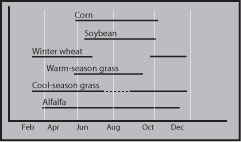Nitrogen is a highly mobile nutrient that can be lost to the air, in runoff and through the soil. The high mobility of nitrogen creates unique nutrient management requirements to ensure fertilizer remains in the soil long enough to benefit your crop.
A significant proportion of a poorly timed nitrogen fertilizer application can be lost before the target crop has a chance to use it. For example, if nitrogen for a corn crop is applied in early fall losses from winter and spring rains can deplete much of the nitrogen fertilizer from the soil before the plant can use it during the growing season.
There are three water quality concerns associated with loss of nitrogen from agricultural fields:
- Using high nitrate-nitrogen drinking water to make milk formula can reduce the oxygen carrying capacity of blood in babies and young livestock.
- Nitrogen in runoff can contribute to eutrophication in some freshwater streams and lakes.
- Nitrogen is the primary contributor to the hypoxic (low oxygen) "dead zone" that forms in the Gulf of Mexico each summer. Nitrogen lost from Missouri fields ultimately reaches the Mississippi River, contributing to the hypoxia problem in the Gulf.
Improving nitrogen management improves both water quality and the effectiveness of fertilizer nitrogen for meeting agronomic goals.
How to prevent nitrogen losses
Avoid overapplication of fertilizer nitrogen
Research has shown that nearly all nitrogen applied in excess of crop needs can be lost from the root zone in humid regions of the United States, including Missouri. To avoid overapplication of nitrogen
- Base nitrogen applications on a fertilizer nitrogen recommendation using an accurate yield goal.
- Adjust fertilizer recommendations for the nitrogen value of previous legume crops such as soybean and alfalfa.
- Adjust fertilizer nitrogen recommendations for the nitrogen value of any manure applications.
- Consider using a preplant nitrogen test on corn and wheat fields with a history of manure application or other situations where you expect large but unknown amounts of available nitrogen in the soil.
- Soil nitrogen tests may be useful after fall or early spring applications of manure or other nitrogen fertilizers when weather patterns may have promoted significant losses of nitrogen.
 Figure 1
Figure 1
Active growing season of common Missouri crops.
Apply nitrogen during periods of active uptake
- There are significant differences among crops in the timing and the duration of active nitrogen uptake and utilization (Figure 1). Applying fertilizer nitrogen close to or during the period of active uptake reduces the possibility of nitrogen losses.
- In cornfields nitrogen applications are equally effective at producing high yields from planting to nearly tasseling time. The biggest obstacle to side-dress nitrogen applications is access to the field when there is a standing crop.
- In winter wheat fields, splitting nitrogen applications between fall and spring will increase yields and reduce nitrogen losses.
- Cool-season forages and winter wheat are best suited for fall and early spring manure applications because they continue active growth into cool weather. Active growth uses nitrogen and water, reducing leaching potential.
Prolong the time nitrogen is held by the soil
There are a number of strategies for extending the window of opportunity for applying nitrogen fertilizer.
- Inject anhydrous ammonia and manure into nearly frozen soils in late fall.
- Injection into nearly frozen soil (below 40 degrees Fahrenheit) will hold nitrogen in the ammonium form, preventing nitrate leaching until after soils warm.
- Use an inhibitor with your fertilizer nitrogen.
- When using urea, apply with a urease inhibitor such as Agrotain.
- When injecting anhydrous ammonia or manure with lots of ammonium nitrogen (e.g., swine lagoon effluent), use a nitrification inhibitor such as N-Serve.
- These products inhibit the activity of soil microorganisms or enzymes for two or more weeks, preventing conversion of the fertilizer into mobile forms of nitrogen. The effectiveness of these products is longer in cold soils that slow breakdown of the inhibitors.
- Decisions on adding inhibitors are larely driven by the cost of the product relative to the potential value of the conserved nitrogen.
Minimizing nitrate leaching
- Do not overapply nitrogen fertilizers.
- Time applications close to crop nitrogen need.
- Avoid fertilization strategies that leave substantial amounts of nitrate nitrogen in the soil over winter.
- Avoid summer applications of manure on wheat stubble for next year's corn crop.
- Avoid fall anhydrous or urea nitrogen applications into warm soil without the appropriate inhibitor.
- Nitrate leaching is more likely on soils that have a high infiltration rate such as sandy soils.
- Overwatering of irrigated soils also causes nitrate leaching.
- Nitrate leaching is less likely on cool-season forages and winter wheat that extend their growing season into the late fall and early spring.
- Apply fall anhydrous ammonia after soil temperature is below 40 degrees Fahrenheit.
- Consider the use of inhibitors to slow the conversion of spring-applied nitrogen to nitrate.
Minimizing ammonia volatilization
- Inject liquid manure into the soil. This is particularly effective for manure with high ammonium-nitrogen content, such as unagitated lagoon effluent.
- Avoid urea fertilizers in high residue conditions unless steps are taken to ensure contact of the fertilizer with the soil.
- Significant rainfall will leach urea into the soil if it falls soon after application.
- Make sure anhydrous ammonia injection slots fully close.